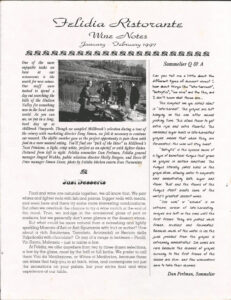 Felidia Ristorante
Felidia Ristorante
Wine Notes
January – February 1997
One of the more enjoyable tasks we have at our restaurants is the search for new wines. Our staff were invited to spend a day out searching the hills of the Hudson Valley for something new in the local wine world. As you can see, we put in a long, hard day up at Millbrook Vineyards. Though we sampled Millbrook’s selection during a tour of the winery with marketing director Doug Simon, we felt it necessary to continue our research. The idyllic weather gave us the perfect opportunity to pair them with food in a more natural setting. You’ll find our “pick of the litter” in Millbrook’s Tocai Friulano, a light, crisp white, perfect as an apertif or with lighter dishes. Pictured from left to right: Felidia sommelier Dan Perlman, Felidia general manager Amgad Wahba, public relations director Shelly Burgess, and Becco & Frico manager Simon Dean; photo by Felidia kitchen extern Ross Posmentier.
∝
Just Desserts
Food and wine are naturals together, we all know that. We pair whites and lighter reds with fish and pastas, bigger reds with meats and even here and there try some more interesting combinations. But often we overlook the chance to try a wine match at the end of the meal. True, we indulge in the occasional glass of port or madeira, but we generally don’t even glance at the dessert wines.
But what could be more natural than a refreshing and lightly sparkling Moscato d’Asti or Asti Spumante with fruit or sorbet? How about a rich Sauternes, Torcolato, Acininobili or Recioto della Valpolicella with chocolate? Or any of a range in between – Picolit, Vin Santo, Malvasia – just to name a few.
At Felidia, we offer anywhere from two to three dozen selections, a few by the glass, most by the half or full bottle. We prefer to call them Vini da Meditazione, or Wines of Meditation, because these are wines that help you to sit back, relax, and contemplate not just the sensations on your palate, but your entire food and wine experience at our table.
Sommelier Q&A
Can you tell me a little about the different types of dessert wines? I hear about things like “late-harvest”, “botrytis”, “ice wine” and the like, and I don’t know what those are.
The simplest one you asked about is “late-harvest”. The grapes are left hanging on the vine after normal picking time. This allows them to get extra ripe and extra flavorful. The increased sugar levels in late-harvested grapes means that when they are fermented, the wine will stay sweet.
“Botrytis” is the species name of a type of beneficial fungus that grows on grapes in certain conditions. The fungus literally pokes holes in the grape skins, allowing water to evaporate and concentrating both sugar and flavor. That and the flavors of the fungus itself create some of the world’s greatest dessert wines.
“Ice wine” or “eiswein” is an extreme version of late-harvesting. Grapes are left on the vines until the first freeze. They are picked while frozen, crushed and fermented. Because much of the water is ice the juice pressed from the grapes is extremely concentrated. Ice wines are rare because the chances of grapes surviving the first freeze of the season are slim, and few winemakers care to take their chances.
Dan Perlman, Sommelier